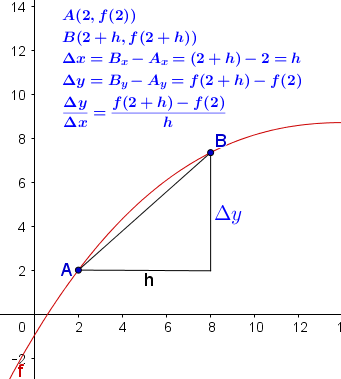Derivative and Slope
The slope of a line, when it exists, is defined as the vertical rate of change divided by the horizontal rate of change. We often put this into symbols as $$m=\frac{\Delta y}{\Delta x}.$$

When we have two points, $A=(A_{x},A_{y})$ and $B=(B_{x},B_{y})$. We know how to define the line slope, since $\Delta y=(B_{y}-A_{y})$ and $\Delta x=(B_{x}-A_{x}).$ Now let's consider that we are given $A_{x}$ but told that $A_{y}$ was to be computed as the output of a function. That is, $A_{y}=f(A_{x}).$ Furthermore, to find point $B$ we are going to progress horizontally a distance $h$ and then use the same function to compute the coordinates of $B.$ $B_{y}=f(A_{x}+h).$ We should also see that $B_{x}=A_{x}+h.$ We can simplify the notation a tiny bit if we let $x=A_{x}.$ Then we have $$\begin{aligned}A_{x}= & x\\ A_{y}= & f(x)\\ B_{x}= & x+h\\ B_{y}= & f(x+h) \end{aligned} $$ $\Delta y$ is still $B_{y}-A_{y}.$ It looks like this. $$\Delta y=f(x+h)-f(x)$$ We may also note that $\Delta x=h.$ That is, we progressed along the $x$-axis from $x$ to $x+h,$ so the change was $B_{x}-A_{x}=(x+h)-x=h.$ Therefore, our slope is $$\frac{\Delta y}{\Delta x}=\frac{f(x+h)-f(x)}{h}. \tag{1} \label{1}$$
The discussion thus far has just been a cumbersome method to define the slope of a line. Figure 1 summarizes and shows the two points, $A$ and $B$ drawn onto some function $f(x)$ that was used to derive them. We can imagine that if $h$ had a different length, then $B$ would fall elsewhere on the curve, $f(x).$ That, of course, would cause the calculated slope to be different from whatever it is now. A fundamental idea in calculus is to compute that slope whenever points $A$ and $B$ are as close to one another as possible. In other words, we want the value $h$ to get smaller and smaller until it is approximately zero. This is the idea of a limit and this particular limit is called the derivative of $f(x)$ and we typically give it symbols like $f^{\prime}(x)$ or $dy/dx.$ $$f^{\prime}(x)=\lim_{h\rightarrow0}\frac{f(x+h)-f(x)}{h} \tag{2} \label{2}$$ This isn't supposed to be an introduction to calculus, so we won't explore how to find that limit, but do understand that what we mean by limit and by $f^{\prime}(x)$ and by $\frac{dy}{dx},$ is that points $A$ and $B$ get unimaginably close together and then we find the slope of the line between them.